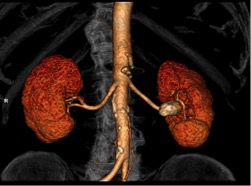Back to 2016 Annual Symposium ePosters
Renal Artery Aneurysm after Trauma Twenty Years Prior: Case Report and Review of the Literature
Michael F. Amendola, MD, Dan Newton, MD, John Pfeifer, MD.
VA Medical Center/VCU Health System, Richmond, VA, USA.
Objectives:
Penetrating trauma to the renal artery is often addressed in the midst of exploratory laparotomy. Traditional teaching mandates retroperitoneal dissection for hemorrhage control and potential urological injury management. Traumatic arterial injury can result in pseudoaneurysm formation, which are often discovered early. However, several authors have reported late asymptomatic and symptomatic presentations.
Methods:
We present a case of a 58-year-old gentleman who underwent chest computer tomography to further evaluate pulmonary nodules. This and follow-up imaging incidentally identified a 2.6 centimeter saccular aneurysm arising from the anterior division of the left renal artery. . History and physical exam revealed several left flank scars and a midline laparotomy scar. These were consistent with the patient’s history of multiple stab wounds to the flank 53 years prior. Following this trauma, he underwent exploratory laparotomy that by his report identified no injury. Given his long, asymptomatic interval between injury and discovery, he has elected to undergo continued observation.
Results:
There have been seven reports of distal history of renal artery aneurysm following penetrating trauma. In all cases management included embolization and possible open operative approach have been undertaken regardless of symptoms. The earliest presentation was three years after trauma the longest fifteen years. To date this is the longest time to presentation after initial trauma to diagnosis.
Conclusions:
Longstanding traumatic renal artery pseudoaneurysms may remain asymptomatic and not require repair. Caution should be undertaken with these patients and careful patient counseling should be undertaken as a late rupture has been reported. Consensus in the literature is lacking in terms in terms of non-operative and open and/or endovascular treatments. 
Back to 2016 Annual Symposium ePosters
|







